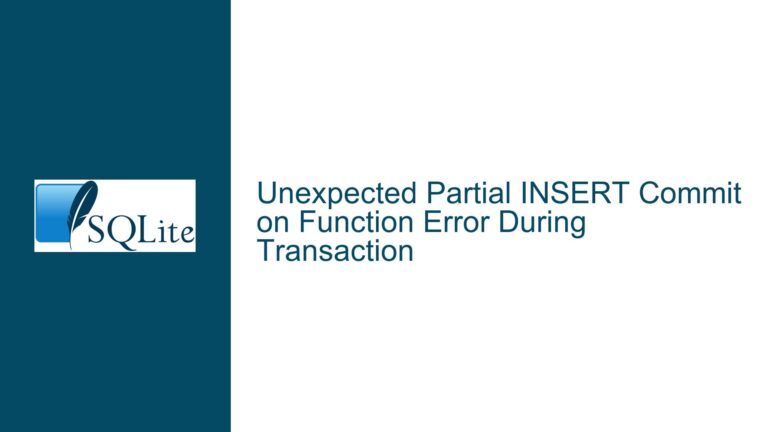Enforcing Required Parameters in SQLite Table-Valued Functions with OR Clauses
Understanding the Behavior of xBestIndex with Required Parameters and OR Clauses
The core issue revolves around the enforcement of required parameters in SQLite table-valued functions (TVFs) when the query includes an OR clause in the WHERE condition. Specifically, the problem arises when the xBestIndex method is called multiple times with different combinations of constraints, some of which omit the required parameter. This behavior is particularly problematic because it can lead to errors even when the query logically should not fail, such as when the required parameter is present in one part of an AND clause but not in another part of an OR clause.
The xBestIndex method is a critical part of SQLite’s virtual table interface. It is responsible for determining the best way to access the data in the virtual table based on the constraints provided in the query. When a query includes an OR clause, SQLite’s query planner (QP) may call xBestIndex multiple times, each time with a different subset of constraints. This is because the QP is trying to find the most efficient way to execute the query by evaluating all possible combinations of constraints.
However, this behavior becomes problematic when the virtual table implementation enforces required parameters. If the xBestIndex method is called with a subset of constraints that omits a required parameter, the implementation may return an error, causing the query to fail. This is counterintuitive because the required parameter may still be present in another part of the query, and the query should logically be able to proceed without error.
For example, consider the following query:
SELECT * FROM test WHERE RequiredParameter=1 AND (Field = 2 OR Field = 3);
In this case, the xBestIndex method may be called twice: once with both RequiredParameter=1 and Field = 2, and once with only Field = 3. If the implementation enforces the presence of RequiredParameter, the second call to xBestIndex will result in an error, even though the required parameter is present in the first part of the AND clause.
This behavior is not a bug in SQLite but rather a consequence of how the query planner works. The QP is designed to explore all possible ways to execute a query, including evaluating subsets of constraints that may not include all required parameters. This is especially true when OR clauses are involved, as the QP needs to consider different paths for each branch of the OR.
The Conflict Between Required Parameters and Query Planner Flexibility
The conflict arises from the tension between the need to enforce required parameters and the flexibility of the query planner to explore different execution plans. When a virtual table implementation enforces required parameters, it assumes that these parameters will always be present in the constraints passed to xBestIndex. However, this assumption does not hold when the query includes OR clauses, as the QP may call xBestIndex with subsets of constraints that omit the required parameter.
This conflict is particularly evident in the case of table-valued functions (TVFs), where the syntax implies an AND relationship between parameters. For example:
SELECT * FROM test(1, 2);
This query is equivalent to:
SELECT * FROM test WHERE RequiredParameter=1 AND Field = 2;
In this case, the TVF syntax enforces that both parameters are required, and the query planner will always include both parameters in the constraints passed to xBestIndex. However, when the query includes an OR clause, the TVF syntax no longer enforces the required parameters, and the QP may call xBestIndex with subsets of constraints that omit the required parameter.
This behavior is not limited to TVFs but can also occur with regular virtual tables. For example, consider the following query:
SELECT * FROM test WHERE RequiredParameter=1 OR Field = 2;
In this case, the QP will call xBestIndex twice: once with RequiredParameter=1 and once with Field = 2. If the virtual table implementation enforces the presence of RequiredParameter, the second call to xBestIndex will result in an error, even though the query should logically be able to proceed without error.
The root cause of this issue is that the virtual table implementation is not aware of the broader context of the query. It only sees the constraints passed to xBestIndex and cannot infer whether the required parameter is present in another part of the query. This lack of context makes it difficult to enforce required parameters in a way that is compatible with the flexibility of the query planner.
Resolving the Issue: Using SQLITE_CONSTRAINT and Best Practices for Virtual Table Implementations
To resolve this issue, the virtual table implementation should use SQLITE_CONSTRAINT instead of SQLITE_ERROR when a required parameter is missing. The SQLITE_CONSTRAINT return code indicates that the query plan omitting the required parameter is not viable, but it does not cause the query to fail. Instead, the query planner will disregard this plan and continue searching for a viable plan that includes the required parameter.
For example, consider the following implementation of xBestIndex:
int xBestIndex(sqlite3_vtab *pVTab, sqlite3_index_info *pIdxInfo) {
bool hasRequiredParameter = false;
for (int i = 0; i < pIdxInfo->nConstraint; i++) {
if (pIdxInfo->aConstraint[i].iColumn == REQUIRED_PARAMETER_COLUMN &&
pIdxInfo->aConstraint[i].usable) {
hasRequiredParameter = true;
break;
}
}
if (!hasRequiredParameter) {
return SQLITE_CONSTRAINT;
}
// Proceed with the rest of the xBestIndex implementation...
return SQLITE_OK;
}
In this implementation, if the required parameter is missing, xBestIndex returns SQLITE_CONSTRAINT, indicating that the query plan is not viable. The query planner will then disregard this plan and continue searching for a viable plan that includes the required parameter. This approach allows the virtual table implementation to enforce required parameters without causing the query to fail when the QP explores different execution plans.
Additionally, the documentation should be updated to clarify the behavior of xBestIndex with required parameters and OR clauses. Developers should be aware that the QP may call xBestIndex with subsets of constraints that omit required parameters, and they should design their virtual table implementations accordingly.
Here are some best practices for implementing virtual tables with required parameters:
Use
SQLITE_CONSTRAINTfor Missing Required Parameters: Instead of returningSQLITE_ERRORwhen a required parameter is missing, returnSQLITE_CONSTRAINT. This allows the query planner to continue searching for a viable plan without causing the query to fail.Document the Behavior of
xBestIndex: Clearly document the behavior ofxBestIndexwith required parameters andORclauses. Developers should be aware that the QP may callxBestIndexwith subsets of constraints that omit required parameters, and they should design their implementations accordingly.Consider the Context of the Query: When designing a virtual table implementation, consider the broader context of the query. If the query includes
ORclauses, the implementation should be prepared to handle calls toxBestIndexwith subsets of constraints that omit required parameters.Test with Complex Queries: Test the virtual table implementation with complex queries that include
ORclauses and other combinations of constraints. This will help identify any issues with the enforcement of required parameters and ensure that the implementation behaves as expected in all cases.
By following these best practices, developers can create virtual table implementations that enforce required parameters while remaining compatible with the flexibility of SQLite’s query planner. This approach ensures that queries with OR clauses can be executed without error, even when required parameters are involved.
In conclusion, the issue of enforcing required parameters in SQLite table-valued functions with OR clauses is a complex one that arises from the interaction between the virtual table implementation and the query planner. By understanding the behavior of xBestIndex and using SQLITE_CONSTRAINT to indicate non-viable query plans, developers can create virtual table implementations that enforce required parameters without causing queries to fail. Additionally, updating the documentation to clarify this behavior will help future developers avoid similar issues and design more robust virtual table implementations.






